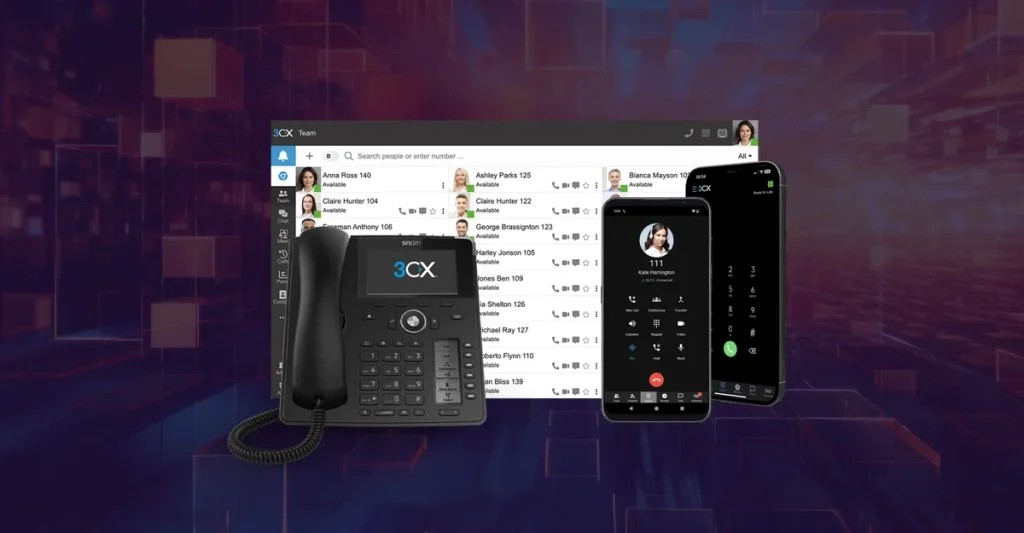With so many businesses acknowledging that advanced VoIP features have greatly improved their communication processes, the potential benefits for your business are undeniable. Imagine being able to optimize call routing, personalize customer interactions, and gauge performance seamlessly. These advanced features not only enhance connectivity but also offer a competitive edge in today’s fast-paced market. Stay ahead of the curve by exploring how these tools can transform your business operations and propel you towards greater success.
Table of Contents
ToggleKey Takeaways
- Enhanced call routing strategies for improved efficiency and customer satisfaction.
- Customized IVR technology for personalized customer interactions.
- Advanced call analytics for communication insights and performance metrics.
- Data security measures and CRM integration for enhanced customer management.
- Automated call distribution and reporting for streamlined call handling.
Enhanced Call Routing
Implementing improved call routing in your business phone system can greatly enhance call management efficiency and customer satisfaction. By strategically utilizing call forwarding strategies and closely monitoring performance metrics tracking, you can streamline your communication processes and make sure that callers are efficiently directed to the most appropriate department or individual.
When considering call forwarding strategies, it’s important to tailor them to suit your specific business needs. Directing calls based on factors like time of day, caller location, or language preferences can greatly improve the overall customer experience. For example, setting up time-based call forwarding ensures that calls outside business hours are redirected to voicemail or an alternate contact, preventing missed opportunities and enhancing after-hours support.
Performance metrics tracking plays a crucial role in evaluating the effectiveness of your call routing system. By monitoring key indicators such as call abandonment rates, average wait times, and first-call resolution rates, you can identify areas for improvement and make data-driven decisions to optimize your call routing setup further. Leveraging this data allows you to continuously refine your call handling processes and make sure that calls are efficiently routed to the most qualified representatives, ultimately enhancing customer satisfaction and boosting operational efficiency.
Interactive Voice Response
When considering Interactive Voice Response (IVR) for your business, focus on three key points:
Call Routing Options, Customized Call Menus, and Automated Call Handling.
These features allow you to efficiently manage incoming calls, provide personalized customer experiences, and streamline call processes.
Call Routing Options
Utilizing Interactive Voice Response (IVR) technology streamlines call routing processes for efficient and personalized customer interactions. When considering call routing options, implementing effective call forwarding strategies and call screening methods can greatly enhance the customer experience.
Call forwarding strategies allow calls to be automatically redirected to the appropriate department or individual, ensuring prompt responses and efficient issue resolution. Additionally, call screening methods enable businesses to filter calls based on predefined criteria, such as caller identification or specific keywords, ensuring that calls are directed to the most suitable recipients.
Customized Call Menus
To enhance your business’s call routing efficiency and customer engagement, incorporating customized call menus through Interactive Voice Response (IVR) technology is a strategic move. Customized call menus allow you to tailor the options presented to callers based on specific criteria like the time of day or the department they wish to reach.
By offering personalized menu choices, you can direct callers more efficiently to the appropriate extensions or departments, reducing wait times and enhancing overall customer satisfaction. Furthermore, with voicemail customization, you can create personalized greetings and instructions for callers when they reach voicemail boxes, adding a professional touch to your business communications.
Implementing these features can streamline call handling processes and provide a more engaging experience for your customers.
Automated Call Handling
Implementing Interactive Voice Response (IVR) technology in your business enhances call handling efficiency and customer interaction through automated call routing and menu customization. IVR systems offer a virtual receptionist that can efficiently guide callers to their desired destination, reducing hold times and guaranteeing a seamless experience.
With IVR, you can set up various call forwarding options to direct calls to the appropriate department or individual swiftly. Additionally, IVR provides advanced call transfer capabilities, allowing for smooth changes between different agents or departments, improving overall customer satisfaction.
Call Analytics Tools
Enhance your business’s call management strategy with advanced call analytics tools that provide in-depth insights into your communication patterns and performance metrics. These tools offer a thorough view of your VoIP system’s functionality, enabling you to make data-driven decisions and optimize your business’s telecommunication operations effectively.
Here are three key benefits of utilizing call analytics tools:
- Call Quality Monitoring: Gain real-time visibility into the quality of your calls, including metrics like jitter, latency, and packet loss. By monitoring call quality, you can identify potential issues promptly and guarantee that your calls maintain the high standards necessary for seamless communication.
- Network Monitoring Capabilities: Track and analyze network performance to identify bottlenecks, latency issues, and other factors that may impact call quality. With network monitoring tools integrated into your VoIP system, you can proactively address network-related issues and uphold a reliable communication infrastructure.
- Performance Metrics Reporting: Generate detailed reports on call volumes, call durations, peak calling times, and more. These performance metrics provide valuable insights into call patterns, helping you optimize resources, improve customer service, and enhance overall operational efficiency.
Call Recording Functionality
When considering call recording functionality, you’ll explore the benefits it offers, such as quality assurance, training opportunities, and dispute resolution support.
It’s important to understand legal compliance requirements related to call recording to guarantee adherence to regulations like GDPR and HIPAA.
Implementing robust data security measures is vital to safeguard sensitive information captured through call recordings and maintain customer trust in your business practices.
Call Recording Benefits
Maximizing your business potential through the utilization of call recording functionality can greatly enhance operational efficiency and customer service quality. Call recording offers significant benefits such as:
- Improved Training: By reviewing recorded calls, you can identify areas for improvement in customer interactions and train your staff effectively.
- Enhanced Quality Control: Monitoring calls guarantees compliance with company standards and helps maintain service quality.
- Dispute Resolution: Having a record of conversations can be vital in resolving misunderstandings or disputes with customers.
Utilizing call recording with attention to call recording privacy and call recording retention policies can provide your business with valuable insights and advantages.
Legal Compliance Considerations
Shifting from the benefits of call recording, businesses must carefully navigate legal compliance considerations when implementing call recording functionality to avoid potential regulatory pitfalls. Regulatory compliance is vital in ensuring that call recording practices adhere to laws and standards. Privacy measures must be implemented to safeguard sensitive information captured during calls.
Businesses need to inform callers about the recording, obtain consent where necessary, and securely store recorded data to prevent unauthorized access. Understanding the legal landscape surrounding call recording, including laws like GDPR and industry-specific regulations, is essential for maintaining compliance. Regular reviews of recording practices and protocols can help businesses stay abreast of any changes in regulations to ensure ongoing adherence to legal requirements.
Data Security Measures
To enhance the security of your call recordings, implement robust encryption protocols to safeguard sensitive data effectively. When considering data security measures for your VoIP system’s call recording functionality, focus on the following key aspects:
- Data Encryption: Utilize strong encryption algorithms to protect call recordings from unauthorized access and guarantee confidentiality.
- Network Security: Implement secure network protocols and access controls to prevent intrusions and data breaches during call recording transmissions.
- Regular Security Audits: Conduct frequent security audits to identify vulnerabilities, assess risks, and proactively address any potential security gaps in your call recording system.
CRM Integration Capabilities
When considering VoIP implementation for your business, understanding the CRM integration capabilities becomes essential for enhancing customer relationship management efficiency. Integrating VoIP with CRM solutions offers numerous benefits. It allows for seamless access to customer data during calls, enabling personalized interactions and improving overall customer satisfaction. By streamlining communication processes, employees can efficiently track customer interactions, leading to enhanced productivity and more insightful analytics for informed decision-making.
Compatibility considerations are important when integrating VoIP with CRM systems. Ensuring that the VoIP solution is compatible with the existing CRM software is crucial to avoid potential technical issues. Additionally, data security should be a top priority when integrating VoIP with CRM platforms. Implementing encryption protocols and access controls can help safeguard sensitive customer information transmitted through VoIP channels.
Advanced Call Queuing
When implementing Advanced Call Queuing, you’ll explore Queuing Optimization Techniques to streamline call flows efficiently.
Manage call traffic effectively by employing Call Priority Management to make sure important calls are promptly attended to.
Enhance customer experience and operational efficiency through Enhanced Call Routing, optimizing call distribution for improved service delivery.
Queuing Optimization Techniques
Queuing optimization techniques in advanced call routing systems enhance efficiency and customer satisfaction through strategic prioritization of incoming calls. To improve performance and customer engagement, consider the following:
- Skill-Based Routing: Direct calls to agents based on their expertise, ensuring customers are connected to the most qualified representatives quickly.
- Predictive Dialing: Utilize algorithms to predict agent availability, reducing wait times and increasing call resolution rates.
- Real-Time Monitoring: Supervisors can monitor call queues in real-time, redistributing workloads as needed to maintain peak service levels.
Incorporating these advanced techniques can streamline operations, boost customer interactions, and elevate overall service quality.
Call Priority Management
To effectively manage call priorities in advanced call queuing systems, you must strategically allocate incoming calls based on predetermined criteria to optimize efficiency and customer satisfaction. Implementing call management strategies is vital for prioritizing tasks within the system.
Priority call handling guarantees that urgent or important calls are addressed promptly, enhancing overall service quality. By setting up rules that automatically assign priority levels to incoming calls, you can streamline operations and improve response times.
Utilizing advanced call queuing features allows for the customization of call routing based on specific criteria, such as customer status or issue severity. This systematic approach enhances productivity and ensures that critical calls are handled with the necessary attention and care.
Enhanced Call Routing
In optimizing call routing efficiency within advanced call queuing systems, strategic allocation of incoming calls based on predetermined criteria is essential for enhancing operational productivity and customer satisfaction. To achieve this, consider the following key aspects:
- Network Optimization: Implement routing protocols that analyze network traffic to guarantee calls are directed through the most efficient pathways.
- Performance Monitoring: Regularly track call metrics such as wait times, abandonment rates, and agent availability to identify bottlenecks and areas for improvement.
- Dynamic Routing Rules: Utilize dynamic routing rules that adjust based on real-time data, ensuring calls are directed to the most suitable agents for quicker resolution.
Voicemail Transcription Services
When considering advanced VoIP features for business, exploring the benefits and functionalities of Voicemail Transcription Services becomes important to enhance communication efficiency and accessibility. Voicemail Transcription Services offer a valuable tool for businesses by converting voicemail messages into text format, allowing for quick and easy review of messages without the need to listen to lengthy recordings. This feature is particularly useful in environments where reading a message is more convenient than listening, such as during meetings or in noisy surroundings.
Voicemail customization options play a vital role in tailoring the voicemail experience to suit specific business needs. With customizable greetings and message settings, businesses can maintain a professional image and provide callers with relevant information or instructions. Additionally, Voicemail Transcription Services often come with advanced security features to safeguard the confidentiality of sensitive messages. Encryption protocols and secure storage mechanisms help protect business communications and guard against unauthorized access.
Video Conferencing Features
Enhance your business communication capabilities with advanced video conferencing features that streamline virtual meetings and collaboration. Implementing these features can revolutionize how your team interacts, leading to increased efficiency and productivity.
Below are three key benefits of incorporating video conferencing into your business operations:
- Video Conferencing Benefits:
- Enhanced Communication: Video conferencing allows for face-to-face interactions, fostering better communication compared to audio-only calls.
- Increased Engagement: Visual cues and non-verbal communication help keep participants engaged, reducing misunderstandings and improving overall meeting effectiveness.
- Cost Savings: By reducing the need for travel, video conferencing can lead to significant cost savings for businesses with remote teams or multiple office locations.
- Remote Collaboration Benefits:
- Improved Team Connectivity: Video conferencing bridges the gap between remote team members, creating a cohesive work environment regardless of physical location.
- Efficient Decision-Making: Real-time collaboration features such as screen sharing and virtual whiteboards facilitate quick decision-making processes.
- Flexible Meeting Scheduling: Remote collaboration tools enable teams in different time zones to coordinate meetings more effectively, maximizing productivity.
Integrating video conferencing features into your business operations can transform the way your teams communicate and collaborate, ultimately driving success and growth in today’s digital landscape.
Multi-Device Support
When considering multi-device support in VoIP systems, you’ll find that device compatibility and seamless integration are key aspects to focus on.
Ensuring that various devices, from desktops to mobile phones, can seamlessly connect and communicate enhances the flexibility and accessibility of your VoIP solution.
Device Compatibility
For seamless integration across multiple devices, ensuring device compatibility is essential in optimizing VoIP services for business operations. When considering device compatibility for VoIP systems, here are key factors to focus on:
- Compatibility Testing: Conduct thorough compatibility testing to verify that VoIP services work seamlessly across all intended devices.
- Device Optimization: Optimize devices for VoIP usage by configuring settings and updating firmware to enhance performance.
- Cross-Platform Support: Guarantee compatibility across various operating systems and devices to maintain a consistent user experience.
Seamless Integration
In order to guarantee seamless integration of VoIP services across multiple devices, meticulous attention to compatibility and configuration settings is essential. Integration challenges may arise when different devices require specific software versions or settings to function properly with the VoIP system.
To ensure smooth functionality, it’s vital to conduct thorough testing across various devices to identify and address any compatibility issues proactively. By addressing these challenges early on and establishing a robust configuration framework, businesses can achieve a smooth and efficient VoIP experience across all their devices.
Prioritizing compatibility and configuration settings not only enhances the user experience but also minimizes disruptions in communication, ultimately optimizing business operations.
Real-Time Call Monitoring
Real-Time Call Monitoring enhances operational efficiency by providing instant insights into ongoing calls within a business communication system. This feature allows you to track call activity in real-time, empowering you to make informed decisions and optimize your call handling strategies effectively. Here’s why Real-Time Call Monitoring is a game-changer:
- Live Call Data: Gain access to real-time statistics on call volume, wait times, and agent availability. This information enables you to address any bottlenecks promptly and guarantee a smooth call flow.
- Quality Assurance: Monitor calls as they happen to assess agent performance, adherence to scripts, and customer interactions. This proactive approach allows you to provide immediate feedback and coaching, improving customer service quality.
- Resource Allocation: With real-time visibility into call queues and agent status, you can dynamically allocate resources based on demand. This flexibility ensures that calls are handled efficiently, reducing wait times and enhancing customer satisfaction.
Automated Call Distribution
Enhance your business communication system’s efficiency with Automated Call Distribution, a feature that revolutionizes call routing and optimization processes. Automated Call Distribution (ACD) streamlines incoming call management by automatically routing calls to the most appropriate agents based on predefined criteria. This advanced system guarantees that customers are connected to the right person quickly, reducing wait times and enhancing overall customer satisfaction.
One key benefit of ACD is its automated call handling capabilities. Calls are intelligently routed based on factors such as caller input, IVR selections, or agent availability. This ensures that each caller is directed to the most suitable agent, improving first-call resolution rates and minimizing call transfers. Additionally, ACD systems can prioritize calls based on urgency or customer importance, further optimizing the call routing process.
Moreover, ACD systems often include call recording functionality, allowing businesses to monitor and review calls for quality assurance and training purposes. By recording and analyzing customer interactions, businesses can identify opportunities for improvement, ensure compliance with regulations, and provide valuable feedback to agents.
Advanced Reporting Options
Improve your business insights with the advanced analytics capabilities offered by our VoIP system’s reporting options. These reporting features provide in-depth data on call handling and performance metrics, empowering you to make informed decisions to enhance your business operations. Here are three key aspects of our advanced reporting options:
- Call Volume Analysis: Gain a thorough understanding of your call traffic patterns through detailed call volume analysis. Identify peak calling times, call distribution across departments, and trends in call frequency. This data can help you optimize staffing levels and improve customer service by ensuring efficient call handling during busy periods.
- Call Duration Metrics: Dive deep into call duration metrics to evaluate the effectiveness of your communication processes. Track average call durations, identify outliers, and analyze call lengths based on different departments or customer queries. This information can assist in refining call scripts, training staff for more efficient interactions, and ultimately enhancing customer satisfaction.
- Call Outcome Tracking: Monitor call outcomes to assess the success of your call handling strategies. Track metrics such as call resolutions, transfer rates, and customer feedback post-call. By understanding call outcomes, you can refine your call routing protocols, improve staff performance, and align your services with customer expectations more effectively.
Harness the power of advanced reporting options to optimize your business’s VoIP operations and drive continuous improvement in call handling and customer service.
SIP Trunking Solutions
Explore how SIP trunking solutions revolutionize your business communication infrastructure by seamlessly integrating voice services over your existing network, maximizing efficiency and cost-effectiveness. SIP trunking offers a cost-effective scalability solution for businesses, allowing you to easily adjust the number of channels required based on your current needs. This flexibility eliminates the need for physical phone lines, reducing costs associated with traditional telephony setups.
One of the key advantages of SIP trunking is its network reliability. By leveraging your internet connection for voice communication, SIP trunking guarantees redundancy and continuity in case of network outages. With automatic failover capabilities, your business can maintain seamless communication even during unforeseen circumstances, enhancing operational resilience.
Moreover, SIP trunking facilitates the consolidation of voice and data services onto a single network, streamlining management and maintenance processes. Centralizing your communication infrastructure simplifies troubleshooting and updates, leading to increased operational efficiency. Additionally, SIP trunking enables the integration of various communication tools and applications, enhancing collaboration and productivity within your organization.
Mobile App Integration
Mobile app integration revolutionizes your business communication by seamlessly connecting your VoIP system with essential productivity tools, enhancing efficiency and collaboration. This integration offers numerous advantages and benefits:
- Mobile App Advantages:
- Flexibility: Access your VoIP system from anywhere, enabling remote work and on-the-go communication.
- Enhanced Communication: Utilize features like video calls, instant messaging, and presence indicators to improve interaction with colleagues and clients.
- Cost-Effectiveness: Reduce expenses by leveraging mobile devices for VoIP calls instead of traditional phone lines.
- Integration Benefits:
- Improved Productivity: Seamlessly switch between VoIP calls and other apps, streamlining workflows and saving time.
- Enhanced Collaboration: Share documents, screens, and information easily during calls, fostering teamwork and innovation.
- Increased Accessibility: Guarantee constant connectivity by integrating VoIP with mobile apps, enabling communication even when away from the office.
Quality of Service Controls
Integrating Quality of Service Controls within your VoIP system guarantees prioritized and optimized data transmission for seamless communication and enhanced user experience. Network optimization plays an essential role in ensuring that your VoIP calls are crystal clear and free from disruptions. By implementing Quality of Service (QoS) mechanisms, you can prioritize voice packets over other data traffic on your network, thereby minimizing latency and ensuring consistent call quality.
Bandwidth management is another key aspect of Quality of Service Controls. Through effective bandwidth management, you can allocate the necessary resources to support your VoIP system’s requirements, preventing congestion and ensuring a smooth flow of voice data. By setting bandwidth priorities for VoIP traffic, you can avoid situations where other data activities on the network interfere with call quality.
Additionally, Quality of Service Controls allows you to set up traffic shaping rules to regulate the flow of data and prevent bandwidth spikes that could impact VoIP performance. These rules help in maintaining a stable network environment conducive to high-quality voice communication. By fine-tuning these controls, you can optimize your network for VoIP traffic and guarantee a reliable and efficient communication system for your business.
Frequently Asked Questions
How Can VoIP Call Analytics Tools Improve Business Decision-Making?
While using VoIP call analytics tools, you can leverage call monitoring and data insights to enhance business decision-making.
By analyzing performance metrics and engaging in predictive analysis, you gain a deeper understanding of call patterns and customer interactions.
This data-driven approach allows you to access valuable insights and drive strategic improvements in your business operations.
Embrace these tools to harness valuable insights and drive strategic improvements in your business operations.
What Benefits Does Voicemail Transcription Services Offer for Businesses?
When considering voicemail transcription services for your business, you’ll appreciate the improved efficiency they bring by converting voicemail messages into text.
This conversion process not only saves time but also enhances accuracy in message retrieval and understanding.
How Does Video Conferencing Enhance Remote Collaboration for Teams?
When it comes to enhancing remote collaboration for teams, video conferencing is a game-changer. By seamlessly integrating virtual whiteboarding and brainstorming, teams can ideate together in real-time.
Features like screen sharing facilitate dynamic presentations, ensuring everyone is on the same page. This interactive platform fosters creativity and boosts productivity, making teamwork feel effortless and engaging.
Why Is Multi-Device Support Crucial for Seamless Communication?
Multi-device support is essential for improved productivity and remote connectivity. Ensuring compatibility across various devices allows for uninterrupted workflow and collaboration, regardless of location.
What Role Do Quality of Service Controls Play in Voip Performance?
Quality of Service Controls are essential for optimizing VoIP performance. By prioritizing and managing network traffic, these controls guarantee that voice data is transmitted smoothly and without delays.
Implementing QoS controls can enhance call quality, reduce latency, and prevent packet loss, leading to a more reliable VoIP experience. Monitoring and adjusting these settings can greatly impact the overall effectiveness and efficiency of your VoIP system.
Final Thoughts
You have now seen how advanced VoIP features can transform your business operations. By utilizing these tools, you can enhance communication efficiency, improve customer satisfaction, and drive success in the competitive landscape.
Embrace the power of advanced VoIP features and unleash your business’s full potential today.






